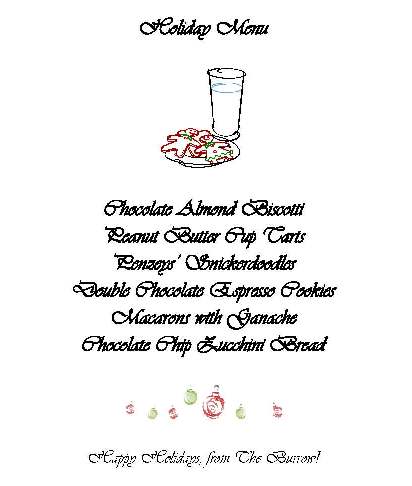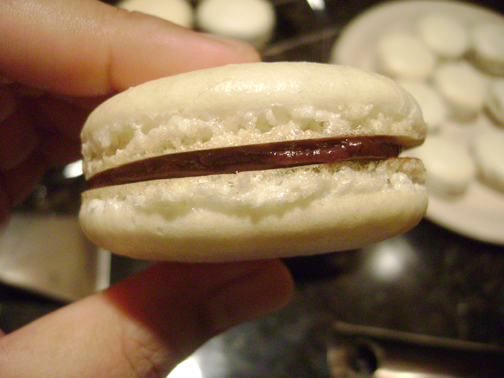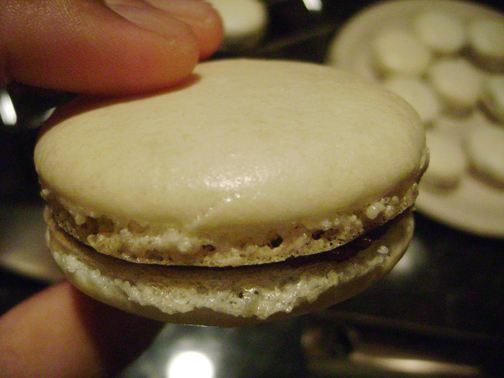My holidays, delivered--with special guest star, macarons
Every year, I look forward to holiday baking. This is when I can go all out, revisiting old favorites and working on new ones, sending treats that people can't easily find.

This year's highlights included Ken's wonderful not-so-hard biscotti and my version of cousin Julius' amazing Espresso White Chocolate Chunk Cookies. I decided to also work on my macarons.

Macarons with chocolate ganache.
Over in one of the kitchn's posts, I suggested that the cupcake fad, if and when it ended, would be replaced with the macaron fad. Personally, while I enjoy cupcakes, I like macarons better; there's much less buttercream involved, and I just love almonds. And cookies. I think the one thing that might prevent the much-anticipated (by me) macaron fad is people's macaron-phobia. Many food blogs I visit show traumatizing attempts at homemade macarons, some never getting it quite right. I say: just go for it.
I like David Lebovitz's no nonsense approach to macarons. When I saw his recipe for French Chocolate Macarons last year, linked over from Serious Eats' "how to make macarons" article, I decided to make that recipe the one to try. No coddling, no disclaimers--just get-up-and-go instructions. As Julia Child once said, "As long as you know what you’re trying to do, there’s no reason to be scared of doing it." Aside from my incredibly overzealous piping and the resulting ball-shaped macarons, the taste and texture were just like the macarons I'd had in Vegas (as dramatically told in that same post). I decided that the next time I made macarons, I'd "pipe better." I ended up making macarons one of the treats I sent out to friends and family as holiday gifts.

Smooth top, frilly feet!
If you try to make these, I recommend you just dive in with gusto. If you can beat egg whites and make a meringue, then you can do this. Just make sure all your beating equipment is grease-free, or your egg whites won't whip up, and don't overwhip your egg whites or your batter will be tought to pipe and your shells will be too dry. You want the batter to be somewhat stiff, but fluid enough to pipe easily and flow gently into a round shape. To pipe, just put your pastry tip down and squeeze until you have a shallow 1-inch circle; if you pipe too tall, you'll end up with what I did my first time out--macaron golf balls! Anyway, this really is the simplest recipe I've found. If you can nail this, then you can feel more at ease when you start experimenting with aged egg whites and fancy flavors.
Almond flour might be hard to find. I just threw some blanched almonds into a food processor with a light sprinkling of AP flour to prevent it from turning into almond paste. I've also had success following Lebovitz's suggestion and grinding the almonds with the powdered sugar in the recipe. If you want to avoid the little bumplies from larger pieces of almond (though in my opinion, they're not large enough to affect the texture), you can run the almond flour through a sifter, then reprocess the large chunks to squeeze a few more grains out of them.
My version of David Lebovitz's macaron shells
Makes about fifteen cookies
Macaron Batter
1 cup (3.5 oz) powdered sugar
½ cup almonds flour (2 oz)
2 large egg whites, at room temperature
5 tablespoons (2 1/4 oz) granulated sugar
1. Line two baking sheets with parchment paper and preheat oven to 375.
2. Get together a pastry bag with a plain 1/2-inch tip.
3. Combine the powdered sugar and almond flour.
4. Beat the egg whites until they begin to rise and firm. While whipping, beat in the granulated sugar until very stiff and firm, about 2 minutes.
5. Fold the dry ingredients, in two batches, into the egg whites until the mixture is just smooth and there are no streaks of egg white.
6. Scrape the batter into the pastry bag (standing the bag in a tall glass helps if you're alone).
6. Pipe the batter onto the parchment-lined baking sheets in flat, 1-inch circles, evenly spaced one-inch apart.
7. Rap the baking sheet a few times firmly on the counter top to flatten the macarons, then bake them for 15-18 minutes.
8. Let cool completely then remove from baking sheet.
I used his Chocolate filling, too:
Chocolate Filling
½ cup (125 ml) heavy cream
2 teaspoons light corn syrup
4 ounces bittersweet or semisweet chocolate, finely chopped
1 tablespoon butter, cut into small pieces
To make the chocolate filling:
Heat the cream in a small saucepan with the corn syrup. When the cream just begins to boil at the edges, remove from heat and add the chopped chocolate. Let sit one minute, then stir until smooth. Stir in the pieces of butter. Let cool completely before using.
I stirred the ganache a lot to thicken it up a bit so it wouldn't be too runny.
The next time I make these (maybe sooner than later because I'm gearing up to make some citrus curds, and I'll have some egg whites left over), I'm going to try some flavored buttercreams. Or heck, maybe use some curds as fillings!

This year's highlights included Ken's wonderful not-so-hard biscotti and my version of cousin Julius' amazing Espresso White Chocolate Chunk Cookies. I decided to also work on my macarons.

Macarons with chocolate ganache.
Over in one of the kitchn's posts, I suggested that the cupcake fad, if and when it ended, would be replaced with the macaron fad. Personally, while I enjoy cupcakes, I like macarons better; there's much less buttercream involved, and I just love almonds. And cookies. I think the one thing that might prevent the much-anticipated (by me) macaron fad is people's macaron-phobia. Many food blogs I visit show traumatizing attempts at homemade macarons, some never getting it quite right. I say: just go for it.
I like David Lebovitz's no nonsense approach to macarons. When I saw his recipe for French Chocolate Macarons last year, linked over from Serious Eats' "how to make macarons" article, I decided to make that recipe the one to try. No coddling, no disclaimers--just get-up-and-go instructions. As Julia Child once said, "As long as you know what you’re trying to do, there’s no reason to be scared of doing it." Aside from my incredibly overzealous piping and the resulting ball-shaped macarons, the taste and texture were just like the macarons I'd had in Vegas (as dramatically told in that same post). I decided that the next time I made macarons, I'd "pipe better." I ended up making macarons one of the treats I sent out to friends and family as holiday gifts.

Smooth top, frilly feet!
If you try to make these, I recommend you just dive in with gusto. If you can beat egg whites and make a meringue, then you can do this. Just make sure all your beating equipment is grease-free, or your egg whites won't whip up, and don't overwhip your egg whites or your batter will be tought to pipe and your shells will be too dry. You want the batter to be somewhat stiff, but fluid enough to pipe easily and flow gently into a round shape. To pipe, just put your pastry tip down and squeeze until you have a shallow 1-inch circle; if you pipe too tall, you'll end up with what I did my first time out--macaron golf balls! Anyway, this really is the simplest recipe I've found. If you can nail this, then you can feel more at ease when you start experimenting with aged egg whites and fancy flavors.
Almond flour might be hard to find. I just threw some blanched almonds into a food processor with a light sprinkling of AP flour to prevent it from turning into almond paste. I've also had success following Lebovitz's suggestion and grinding the almonds with the powdered sugar in the recipe. If you want to avoid the little bumplies from larger pieces of almond (though in my opinion, they're not large enough to affect the texture), you can run the almond flour through a sifter, then reprocess the large chunks to squeeze a few more grains out of them.
My version of David Lebovitz's macaron shells
Makes about fifteen cookies
Macaron Batter
1 cup (3.5 oz) powdered sugar
½ cup almonds flour (2 oz)
2 large egg whites, at room temperature
5 tablespoons (2 1/4 oz) granulated sugar
1. Line two baking sheets with parchment paper and preheat oven to 375.
2. Get together a pastry bag with a plain 1/2-inch tip.
3. Combine the powdered sugar and almond flour.
4. Beat the egg whites until they begin to rise and firm. While whipping, beat in the granulated sugar until very stiff and firm, about 2 minutes.
5. Fold the dry ingredients, in two batches, into the egg whites until the mixture is just smooth and there are no streaks of egg white.
6. Scrape the batter into the pastry bag (standing the bag in a tall glass helps if you're alone).
6. Pipe the batter onto the parchment-lined baking sheets in flat, 1-inch circles, evenly spaced one-inch apart.
7. Rap the baking sheet a few times firmly on the counter top to flatten the macarons, then bake them for 15-18 minutes.
8. Let cool completely then remove from baking sheet.
I used his Chocolate filling, too:
Chocolate Filling
½ cup (125 ml) heavy cream
2 teaspoons light corn syrup
4 ounces bittersweet or semisweet chocolate, finely chopped
1 tablespoon butter, cut into small pieces
To make the chocolate filling:
Heat the cream in a small saucepan with the corn syrup. When the cream just begins to boil at the edges, remove from heat and add the chopped chocolate. Let sit one minute, then stir until smooth. Stir in the pieces of butter. Let cool completely before using.
I stirred the ganache a lot to thicken it up a bit so it wouldn't be too runny.
The next time I make these (maybe sooner than later because I'm gearing up to make some citrus curds, and I'll have some egg whites left over), I'm going to try some flavored buttercreams. Or heck, maybe use some curds as fillings!
Comments
That macaron is perfect!
I have never made them again since my last attempt. It took me seven batches to get a tray that did not have any cracks.
If you have any advice on this subject, let me know. :)
Anna, thanks! I went to Las Vegas early last year, and that was my first long-awaited taste of the macaron. It really is similar to a meringue (cookie, not pie topping)--light and airy and crisp. The difference is the addition of a nut flour (usually almond)--adds great flavor and a slightly more substantial mouth feel. I can't wait to see your macarons! Just remember--be fearless! If you can whip up egg whites, you can work up macaron batter!